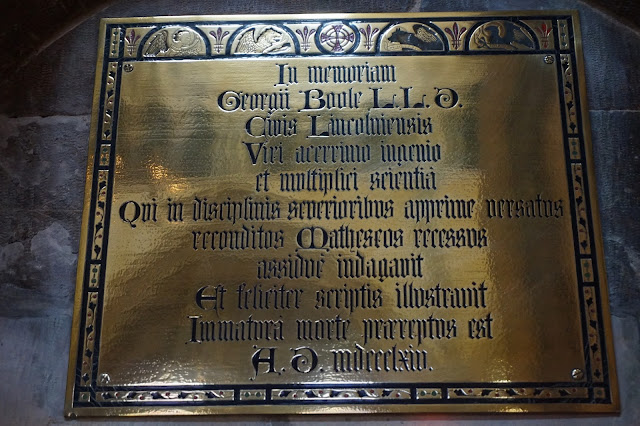This story takes place mainly in Lincoln, which was one stop ago for me now that I'm in Cambridge, so I'm backing up a bit in time as I post this.
 |
| Pottergate, Lincoln, England |
The gate pictured above and below is Pottergate Arch, which is just a dozen yards or so below a home that Boole lived in and also ran a school from in Lincoln, which in turn is about 50 yards below the cathedral. Pottergate was once the main entrance to the grounds of Lincoln Cathedral from Lindum Road. It is the south gate of the south close wall that was built in the 14th century to enclose properties of the dean and chapter.
 |
| Pottergate, Lincoln, England |
In childhood George began going to school before he was two years old - a school for children of tradesmen. After his first year of schooling he went to a commercial school, which he attended until he was seven. After this he attended a primary school. George's father had shared his love of math and science with George early in George's life, and George picked up on that love. As George moved through school he also developed a love for languages.
 |
| Boole's Home and School |
 |
| Plaque on Boole House and School |
As these images progress we go from Pottergate at Lindum Road, up Pottergate Road and past the house and then on to Minster Yard and the Cathedral.
 |
| Looking up the street from Boole's house you see the central tower of Lincoln Cathedral |
 | ||||||||
Continuing up Pottergate Road and looking back past Boole's house toward Pottergate
The fourth window from the west entrance on the north side of the church is dedicated to George Boole. I've taken a number of photographs so that you can see the whole window, each of the three elements of the window, the plaque, and also the window and plaque with respect to each other. Each element of the window has to do with teaching and learning - Samuel, near Eli, answering God's call - Jesus teaching in the temple at age 12 - the apostles learning at Jesus' feet.
George lived very near Lincoln Cathedral and must certainly have heard the bells loud and clear from his home that was pictured earlier in this post - and probably in other places in which he had lived in Lincoln as well. George didn't worship a the cathedral, however, he worshiped at St. Swithin's. The church pictured below is the new St. Swithin's, and below that is the spot of the former church building where he would have worshiped.
Let's see - I left off George's story at primary school. He continued his education, but never in a school that had much to offer someone with his talent, as his family could not afford such a school. Also due to financial circumstances he never did earn an academic degree, and at age 16 he was forced into a position of helping to support his family when his father's business collapsed. George became an assistant school teacher in Doncaster. And, after having taught in a couple of different locations, he returned to Lincoln at age 19 and opened his own school. It was somewhat later, in 1840, that he opened the boarding school pictured in this post. His family then moved in with him.
After beginning a correspondence with mathematician Augustus De Morgan in 1842, he published a paper in the Transactions of the Royal Society in 1844 - a pretty amazing feat given his social status and lack of institutional education. After this publication he began to be highly recognized for his mathematics. He received the Society's Royal Medal for this work. Eventually Boole was awarded the chair in mathematics at Queen's College, Cork, Ireland.
Throughout his career Boole was a very dedicated teacher - maybe too dedicated. One day in 1864 he walked two miles from his home to the college in pouring rain. Rather than cancel class or take time from class to dry off, he lectured in his wet clothes and developed a chill. Unfortunately, his wife's understanding of "medicine" was that the cure should resemble the cause, so as he lay ill at home she poured buckets of water over him, since it was wetness that had caused his illness. His illness worsened, and he died of a fever-induced pleural effusion.
They'd had a very happy marriage, which produced five daughters. His wife was not an unintelligent woman in general - not at all. In fact, she helped him with his greatest work, and, after his death when she was 32 years old, she was invited to become librarian at Queen's College, London. She tutored in mathematics and had strong opinions on education. She is also known for having invented "curve stitching" and for being the niece of George Everest, after whom the mountain is named.
The work of George Boole's that she contributed to in an editorial role was his ground-breaking An investigation into the Laws of Thought, on Which are founded the Mathematical Theories of Logic and Probabilities. This work was a fundamental step in the computer revolution, which is so intrinsic to our lives today.
|















No comments:
Post a Comment